Rearing Romalea microptera
The Eastern Lubber grasshopper is one of the giants of the Eastern
U.S. insects and one of the largest of all grasshoppers. Despite small
wings a large female measured from head to tail can be more than 80mm.
On the left is a photo of the yellow form of this sp. and on the right
is the black form. Strangely, neither form throws nymphs of the other color.
Nymphs of both forms are black but the black morph continues to keep red
highlights after the first molt while the highlights of the olive morph
change to yellow.
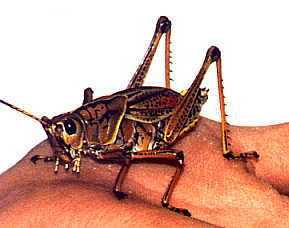
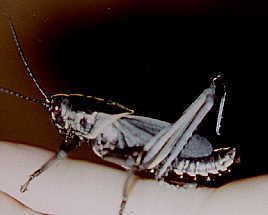
Food: Romalea will eat many things including rose, wheat, blackberry,
dog food, fish food carrots, and romaine lettuce. Both nymphs and adults
can eat the same things but it is best to give the nymphs more in the way
of foliage for the first few molts. Dry dog food pellets are eaten only
by sub adults/adults, those individuals with large and powerful jaws.
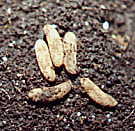
Life cycle: Egg cases are laid 4 or more inches deep into the substrate.
Romalea microptera females lay egg cases of 30 or more eggs which hatch
after 4-5 months at room temperature. These hatchlings need some moisture
and should be fed fresh greens every day or two. Nymphs molt about every
3 weeks until the final molt which takes nearly twice that long. Adult
females wait a minimum of 2 weeks after the final molt before beginning
to lay eggs.
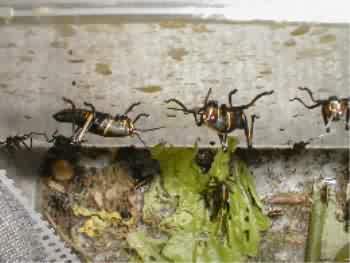
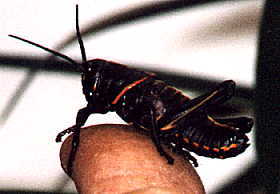 Difficulties:
The
most difficult part of getting the Eastern Lubbers through is ova care.
Drying out of the ova will wipe out every egg in a as short as a few hours;
keeping in a nearly airtight container on a moist soil substrate will keep
the eggs in good shape. Also, it is very important to have angled surfaces
such as branches so that the nymphs can molt successfully. A high survival
rate (successful molting) can be achieved if, in addition to the above
requirements, they are kept in a screen-walled cage such as those used
for chameleons.
Difficulties:
The
most difficult part of getting the Eastern Lubbers through is ova care.
Drying out of the ova will wipe out every egg in a as short as a few hours;
keeping in a nearly airtight container on a moist soil substrate will keep
the eggs in good shape. Also, it is very important to have angled surfaces
such as branches so that the nymphs can molt successfully. A high survival
rate (successful molting) can be achieved if, in addition to the above
requirements, they are kept in a screen-walled cage such as those used
for chameleons.
Back
to the Insects

 Difficulties:
The
most difficult part of getting the Eastern Lubbers through is ova care.
Drying out of the ova will wipe out every egg in a as short as a few hours;
keeping in a nearly airtight container on a moist soil substrate will keep
the eggs in good shape. Also, it is very important to have angled surfaces
such as branches so that the nymphs can molt successfully. A high survival
rate (successful molting) can be achieved if, in addition to the above
requirements, they are kept in a screen-walled cage such as those used
for chameleons.
Difficulties:
The
most difficult part of getting the Eastern Lubbers through is ova care.
Drying out of the ova will wipe out every egg in a as short as a few hours;
keeping in a nearly airtight container on a moist soil substrate will keep
the eggs in good shape. Also, it is very important to have angled surfaces
such as branches so that the nymphs can molt successfully. A high survival
rate (successful molting) can be achieved if, in addition to the above
requirements, they are kept in a screen-walled cage such as those used
for chameleons.